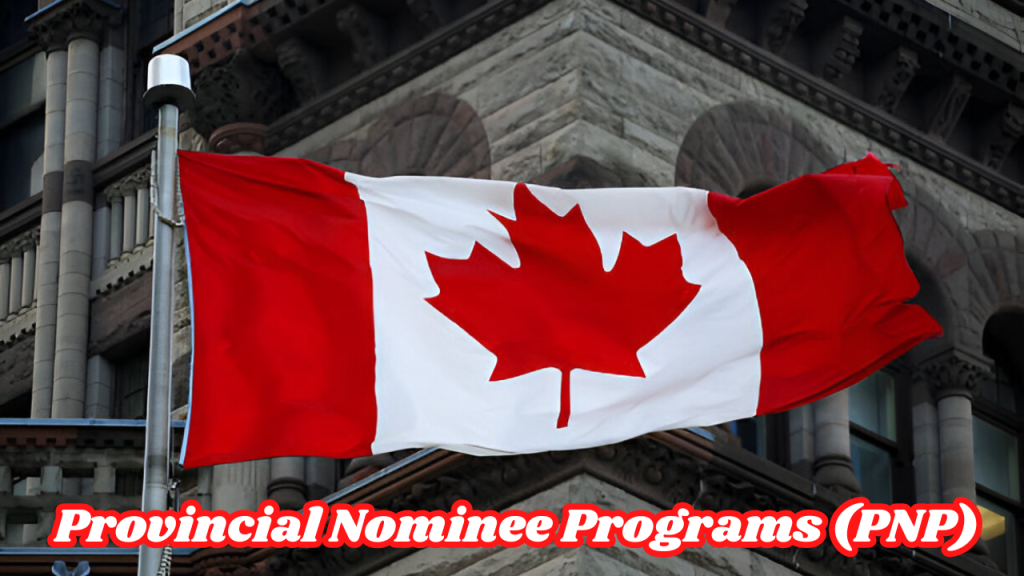The Provincial Nominee Programs (PNP) are key for those wanting to live in Canada. They let provinces and territories pick candidates for permanent residence. This is done to meet local economic needs and fill labor gaps.
By joining the Canada PNP, applicants boost their chances of getting permanent residency. They also help their chosen communities grow.
What are Provincial Nominee Programs?
Provincial Nominee Programs (PNP) are key immigration paths in Canada. They are made by provinces and territories. These programs help local governments find people with the right skills for their areas.
By joining the PNP, people can greatly improve their chances of getting permanent residency in Canada.
The PNP aims to bring in skilled workers to meet local job needs. Provinces look at things like work history, education, and language skills. This way, newcomers can do specific jobs and help the economy grow.
For those wanting to live in Canada, the PNP makes things easier. It helps people avoid some common Canada immigration hurdles. By meeting provincial standards, candidates can find a smoother way into Canadian life.
Benefits of Participating in PNP
Joining the Provincial Nominee Program (PNP) brings many benefits. It makes moving to Canada easier and boosts your chances of getting permanent residency. This program helps you find work and settle in Canada smoothly.
Work Opportunities in Canada
One big PNP benefit is the chance to find work in Canada. Many provinces need skilled workers in fields like tech, healthcare, and trades. This means more job openings for you, matching your skills.
Canada’s job market is stable and diverse. This makes it a great place for immigrants to find work.
Enhanced Immigration Prospects
Getting a provincial nomination also improves your immigration chances. It often speeds up your permanent residency application. This means you can start your new life in Canada faster.
With the PNP, you get to work in Canada and get your residency quickly. This makes the PNP a great choice for many.
Overview of PNP Streams
Provincial Nominee Programs offer different PNP streams. These streams match various skills and experiences needed in the job market. Knowing these categories is key for those wanting to move to Canada.
Different Categories of PNP Streams
The many PNP categories help candidates find the right path. Some well-known ones include:
- Skilled Worker Streams: For those with professional experience in needed jobs.
- International Graduate Streams: For students who have graduated from a Canadian school.
- Employer-Specific Streams: For those with a job offer from a specific employer.
Each category has its own rules. It’s important for applicants to check their options carefully.
Choosing the Right Stream for You
Choosing the right PNP stream is crucial. It depends on your skills and career goals. Here are some tips:
- Look at your employment experience and skills to find the right stream.
- Learn about the province’s needs to make sure it’s a good fit.
- Visit official immigration websites for more information on streams.
- Get advice from immigration experts for personal help.
By following these steps, you can pick the best stream. This will help you have a better chance of getting accepted.
Provincial Nominee Program Requirements
Understanding the provincial nominee program requirements is key for applicants. Each province has its own PNP eligibility criteria. But, there are common factors that most provinces look for.
Eligibility Criteria for PNP
The PNP eligibility criteria include several key points:
- Age
- Education level
- Work experience
- Language proficiency
- Job offer from a local employer
- Connection to the province (e.g., family ties or prior education)
Meeting these criteria is crucial for a successful application. Each province has its own way of weighing these factors. So, it’s wise to research the specific program you’re applying for.
Common Documentation Needed
Applicants need to gather the right documentation for PNP. You’ll typically need:
- Proof of work experience
- Educational credentials
- Language test results
- Job offer letter (if applicable)
- Medical examinations and police clearance
Having accurate and complete documents is crucial. It boosts your chances of approval. Successful applicants make sure they meet all provincial nominee program requirements before applying.
PNP Application Process
The PNP application process might seem tough at first. But, knowing the steps makes it easier. It involves several stages to help you get ready for Canada.
Steps to Apply for the PNP
To apply for the PNP, follow these steps:
- Find the right PNP streams for your skills and job needs.
- Collect all needed documents like ID, qualifications, and work history.
- Send an Expression of Interest (EOI) to your chosen province.
- After nomination, apply for permanent residence with IRCC.
Timeline for Application Processing
The time it takes to process your application varies. Each province has its own pace, depending on the stream. Expect the whole process to take a few months. Stay patient and organized during this time.
Express Entry and PNP Programs
Express Entry and PNP programs work together to help skilled workers. They let provinces pick the right candidates for their needs. This way, those candidates can get permanent residency in Canada.
How Express Entry Works with PNP
The Express Entry system uses points to judge candidates. It looks at their skills, education, and work history. If someone chooses PNP programs, they get a big boost in the Express Entry race.
A provincial nomination can add 600 points to a candidate’s score. This makes it much easier to get an Invitation to Apply for permanent residency.
- Candidates enter the Express Entry pool and are ranked based on their CRS score.
- A nomination through PNP programs signifies support from a province, indicating the applicant’s potential to contribute to the local economy.
- Provinces select candidates from the Express Entry pool based on their own labor market needs, enhancing the efficiency of the immigration process.
This teamwork makes the application process smoother for skilled workers. It also makes sure candidates fit well with Canadian provinces.
Provincial Nomination Canada: An Overview
Provincial nomination in Canada is key to understanding how provinces shape immigration. Each province has its own immigration rules to meet economic needs. This helps bring in skilled workers and boosts local economies.
The Role of Canadian Provinces
Provinces play a big role in immigration by choosing who to nominate. They use Provincial Nominee Programs (PNPs) to attract skilled workers. This way, each province can pick candidates that fit their specific needs.
Understanding Provincial Nomination Benefits
Getting a provincial nomination can really help newcomers. It makes getting permanent residency faster. Plus, nominees can find jobs that match their skills, helping them settle in and grow economically.
Choosing the Right Province for Nomination
Choosing a province for PNP nomination is a big step in your immigration journey. It’s important to look at different factors to find the best match for your lifestyle and career. Knowing the province’s job market, living conditions, and support services is key to making a good choice.
Factors to Consider When Selecting a Province
- The province’s economic stability and growth potential
- Employment opportunities in your field of expertise
- Cost of living and housing affordability
- Diversity and cultural integration
- Access to support services for newcomers
Popular Provinces for PNP Applications
Some provinces are more popular for PNP applications because they offer great conditions for immigrants. Ontario, British Columbia, and Alberta are top choices because of their strong economies and many job opportunities. By researching these provinces, you can match your skills with their needs, improving your chances of getting nominated.
Tips for a Successful PNP Application
Applying for a Provincial Nominee Program (PNP) is a big step towards Canadian residency. To do well, focus on the key parts of preparing your application. A well-prepared application is key to success. Here are some tips to help you get approved.
Preparing Your Application Efficiently
To make your PNP application stand out, follow these steps:
- Thoroughly review eligibility criteria: Know what the program needs to avoid mistakes.
- Gather complete documentation: Make sure all documents are ready and correct.
- Stay updated on policy changes: Immigration rules can change, affecting your application.
- Seek professional guidance: If you’re unsure, an immigration expert can help.
Common Mistakes to Avoid
Many applicants make simple errors. To improve your application, avoid these mistakes:
- Incomplete information: Missing details can get your application rejected.
- Misunderstanding document requirements: Not knowing what documents are needed can cause delays.
- Ignoring deadlines: Being on time is crucial; missing a deadline can stop your application.
- Neglecting to double-check for accuracy: Even small mistakes, like typos, can cause big problems.
Transitioning from PNP to Permanent Residency
Getting a provincial nomination is a big step towards becoming a permanent resident in Canada. It’s important to know what to do next to make the transition smooth. The application process with IRCC has specific requirements that you must meet to get your residency.
Steps After Receiving Nomination
After getting a positive provincial nomination, you start your journey to permanent residency in Canada. Here are the main steps you need to take:
- Complete your application: Fill out the right application forms after your nomination.
- Gather necessary documents: You’ll need proof of your nomination, ID, and education.
- Submit medical examinations: You must pass medical checks to show you’re healthy.
- Background checks: You’ll need to provide documents for criminal background checks.
- Submit your application to IRCC: Send in all your documents and the completed application.
By following these steps carefully, you can move from PNP to permanent residency. Each step is important for getting approval and starting a new life in Canada.
Real-Life Success Stories
Immigrating to Canada is a journey filled with ups and downs. Many have overcome the Provincial Nominee Program (PNP) challenges. Their stories highlight the hurdles and victories that shape their lives.
Inspiring Journeys of Newcomers
Every story is a light of hope for those who come next. They prove that with effort and will, success is within reach. Here are some common themes in these inspiring newcomer experiences:
- Cultural Adaptation: Many immigrants in Canada share their journey of embracing a new culture while keeping ties to their roots.
- Professional Growth: Success stories abound of newcomers advancing in their careers thanks to Canada’s job-rich markets.
- Community Building: Often, stories highlight the support networks formed among immigrants, making the transition smoother.
The resilience of these newcomers showcases the PNP’s transformative power. Their tales are a testament to Canada’s lively and varied society.
Conclusion
Provincial Nominee Programs (PNP) are a fantastic route for skilled workers to begin their Canadian journey. These programs are designed for those eager to work in Canada. They make it simpler for individuals to move to this diverse country.
Understanding the various PNP streams and their requirements is crucial. It helps immigrants grasp how to proceed. By joining these programs, people can boost their chances of a successful move to Canada and career growth.
As these programs evolve, staying informed is vital. This empowers hopeful immigrants to pursue their dreams. The advantages of going through the PNP are immense. They enhance people’s lives and contribute to Canada’s economic growth.








